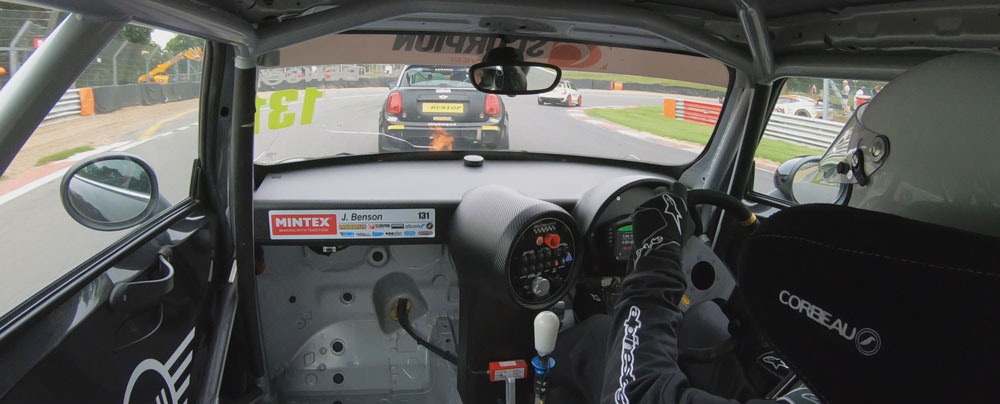Dunlop tires have a rich heritage in racing. They successfully support championships such as the WEC, touring car series across the world, all manor of grass roots motor sport, and the UK based Mini Challenge which is now the feeder series to the hugely popular British Touring Cars.
In order to better understand the challenges of supporting such a competitive series, Dunlop were kind enough to invite me to drive a round of the Mini Challenge, at the difficult Brands Hatch GP Circuit in Kent.

The Mini Challenge Car
Firstly, the cars. They may start their life out as a factory built Mini Cooper, but the final result is nothing short of a mini touring car. They are fully stripped, caged, four way adjustable damping, custom setup, FWD monsters. As with the bigger brother, the other key change for the Mini is the tires is runs, in this case a Dunlop Slick. The Dunlop slick used is now the same size as the BTCC used to use, with matching compounds, and they're appropriately named the "touring car spec" slick. Each team are only allowed to use 4 new a weekend, so 36 in total, but you can run previously used tires for practice and qualifying sessions if you choose to do so. The tires don't like to be overdriven, but last well for a slick if you keep your pressures, cambers and wheel spin to a minimum.

Why do tire manufacturers such as Dunlop go to this huge effort? Mickey Butler, Motorsport Engineer at Dunlop explains “Racing is one of the most important ways to test your product to the extreme. Nothing can provide more feedback than being on the limit during close racing like Mini Challenge or BTCC. From heavy cornering to sharp braking, fast responses to wet weather performance, we are constantly reviewing the performance of our racing tires and transferring the technologies developed on track to our road going products.”
The Race
So, how did the weekend go? Without wanting to sound like a typical racing driver, it was a difficult introduction to what is a VERY competitive series. The number one rule of guest driving is "don't damage the car", which having had everyone tell me how difficult the Mini Challenge car was to drive, meant excess caution was the order of the day. Combined with the fact I've never raced FWD, I'd never raced on slicks, and I'd never driving the GP circuit at Brands, my hopes weren't high for a good result... or even finishing!

The first issue was the fact the practice day, where you have 4 x 20 minute sessions to learn the car and track, was on the shorter Indy circuit, not the much longer and more challenge full GP circuit which I'd never driven. By the end of the practice day I felt like I had a good handle on the car, and with a little track knowledge I finished the day less than a second from the fastest on the grid. The team were impressed, I was happy.
The next day brought the first chance I had to drive the full GP circuit, the 20 minute qualifying session, which also required scrubbing in a set of new tires for the race meaning I had four fast laps in total of the full circuit. Unsurprisingly, that didn't end well, a full 5 seconds off the pace.

Race day comprised of two twenty minute sessions, so a plan formed. I would use the first race to find some space at the very back, and use the twenty minutes to learn the full track and car in order to have a better chance of at least racing in the second race. This plan got off to a great start, with a poor launch from the line and getting swamped into turn one, putting me effectively in last. Sadly, due to the "touring car nature" of the mini challenge, the race was put under a safety car after just nine minutes, then red flagged one lap after the safety car went in. This meant I'd had just another six laps of learning the new part of the track. Not really enough.
Starting in nineteenth of twenty six for the second race, I gave myself two goals. Legitimately overtake for position, and end up with my fastest lap within two seconds of the winning car. Again, my start was poor, losing places off the line (you never get a chance to practice start at Brands), but this time I made sure I stayed with the group and started racing.

The first half of the race had some great battles for the late teen positions, and with a number of legitimate overtakes for position, I found myself in seventeenth place and a clear track. As the race went on, I felt more and more confident with the new parts of the circuit, and with my team telling me there was just a few minutes left of the race, I decided to use my final lap to go all out and try and achieve my target of getting within two seconds of the fastest lap. Fortunately, with just a couple of small errors, and still being overly cautious on the really fast corners, I set a time 1.8 seconds slower than the race winners fastest lap.
My time with the Mini Challenge car was an excellent learning experience. FWD is an art in itself, and the challenge of using slicks properly was something I really enjoyed. The Dunlop slick was a better tire than I was a driver, and that's the best thing I could ever say about a tire. I'm confident that nowI understand the car and circuit, another session woul yield much better results.
A huge thank you once again to Goodyear Dunlop.







